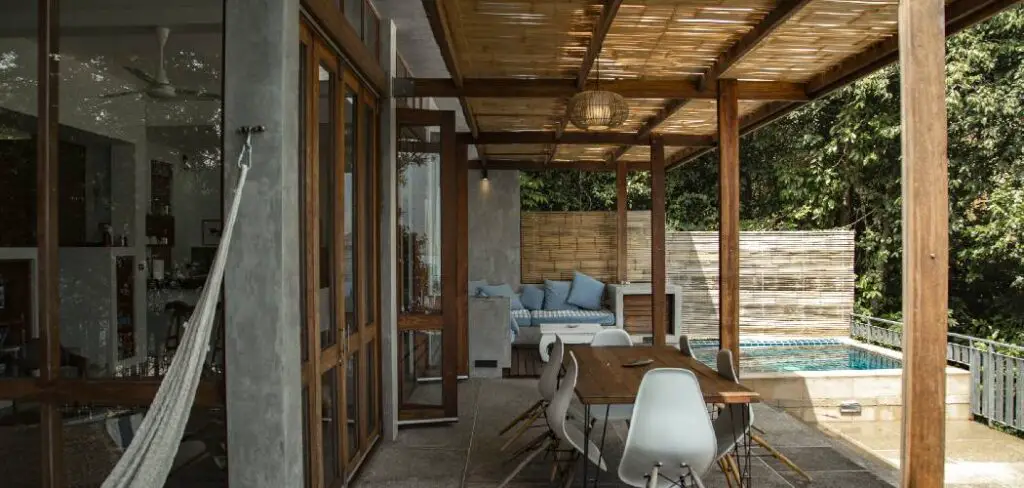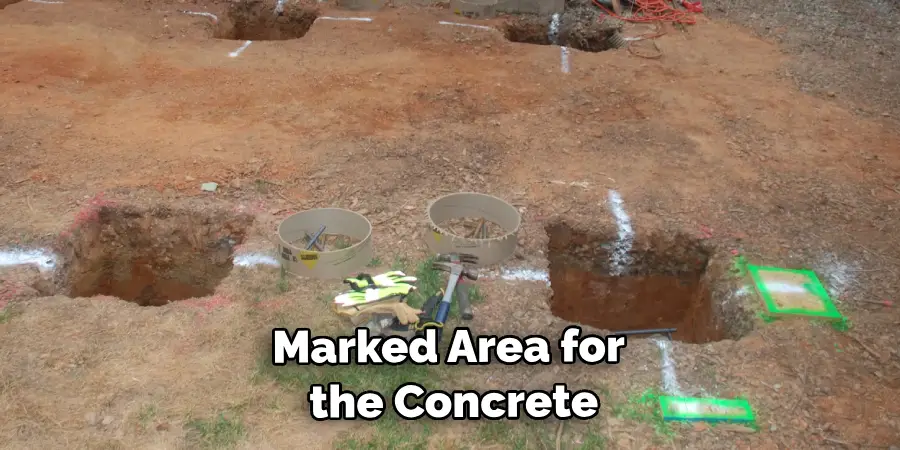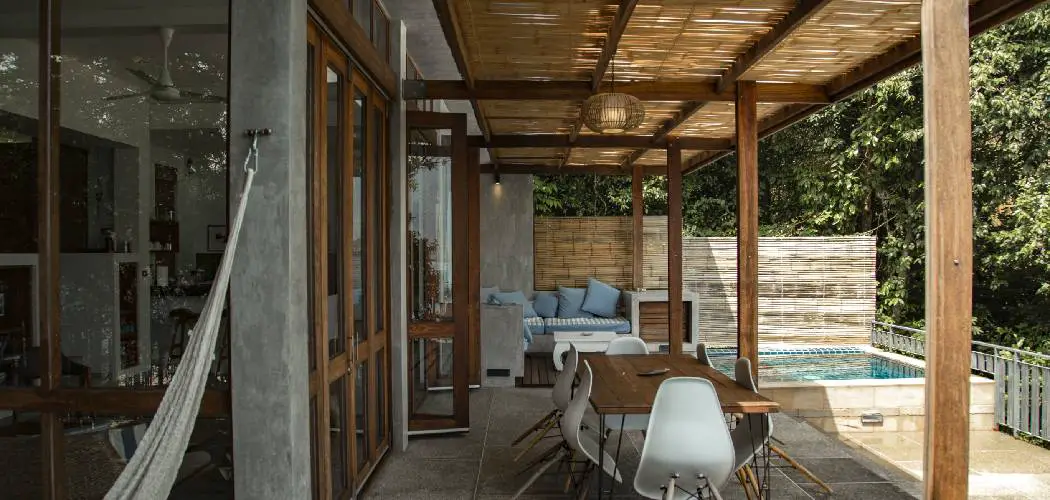Building a floating deck with pergola is an excellent addition to any outdoor space. Not only does it create a beautiful and functional area, but it also adds value to your home. A floating deck is a great option for those who have uneven or sloped ground, making it difficult to build a traditional deck. With the added feature of a pergola, you can create a shaded and cozy space to relax or entertain in.

The main advantage of building a floating deck with pergola is its versatility. It can be built in any outdoor space, regardless of the terrain. Plus, it can be easily customized to fit your specific needs and design preferences. Also, a floating deck requires minimal digging and preparation work compared to a traditional deck, making it a more cost-effective option. In this blog post, You will learn in detail how to build a floating deck with pergola.
Tools You Will Need
- Measuring tape
- Hammer
- Level
- Drill
- Circular saw
- Safety glasses
- Work gloves
- Deck screws
- Post anchors
- Pergola kit
Building a deck with a pergola can be a great addition to your outdoor space. Not only does it provide shade and privacy, but it also adds character and value to your home. In this guide, we will discuss the necessary tools and materials needed to build your own floating deck with a pergola.
Step by Step Processes for How to Build a Floating Deck With Pergola
Step 1: Inspect the Area
Before starting any construction, it is important to inspect the site where you plan to build your floating deck with pergola. Make sure that there are no underground utility lines or sprinkler pipes that could be damaged during construction. Also, check for any uneven ground or rocks that may need to be removed.
Step 2: Gather Materials and Tools
Once you have inspected the area, it’s time to gather all the necessary materials and tools for your project. This may include wood planks, concrete deck blocks, screws, nails, a level, drill, saw, and measuring tape. Using a measuring tape and stakes, mark out the area where you want your floating deck to be built. Use a level to ensure that the ground is even and make any necessary adjustments.
Step 3: Dig Holes for Deck Blocks

Dig holes in each marked area for the concrete deck blocks to be placed. The depth of these holes should be at least 6 inches to provide stability for your floating deck. Once the holes are dug, place the concrete deck blocks in each hole and make sure they are level. These will serve as the foundation for your floating deck.
Step 4: Install Support Beams
Using pressure-treated wood, install support beams on top of the concrete deck blocks. Make sure they are securely attached with screws or nails. Lay out the decking boards on top of the support beams, making sure they are evenly spaced. Use a level to ensure that they are flat and make any necessary adjustments.
Step 5: Secure Decking Boards
Using screws or nails, secure the decking boards onto the support beams. To build your pergola, use pressure-treated wood to create the frame. This can be done by attaching two upright posts to the deck beams and adding a crossbeam on top to connect them. Finally, add the roof of your pergola using wooden slats or a lattice design. Make sure it is securely attached to the frame.
By following these steps, you can successfully build a floating deck with pergola in your backyard. Remember to always follow safety precautions and use proper tools and materials for the job. With a little hard work and patience, you can create a beautiful outdoor space to enjoy with family and friends.
Tips for How to Build a Floating Deck With Pergola

- Before starting any construction work, make sure to wear appropriate protective gear such as gloves, safety glasses, and sturdy footwear to protect yourself from potential hazards.
- Always check with your local building codes and obtain any necessary permits before starting the project. This will ensure that your deck is built to code and safe for use.
- Assemble all necessary tools and materials beforehand to avoid interruptions during the construction process. This will also prevent any accidents caused by rushing or improvising with inadequate equipment.
- Begin by preparing the site, making sure the ground is level and clear of any debris or potential hazards. This will provide a sturdy base for your deck and pergola.
- When constructing the deck, use pressure-treated lumber to prevent rotting and make sure all pieces are attached securely with galvanized screws or nails.
- Take extra precautions when working at heights by utilizing safety harnesses and making sure the ladder or scaffolding is secure.
- Do not attempt to build a floating deck with pergola on your own. Always have at least one other person present to assist and provide help in case of emergency.
Are There Any Maintenance Tasks You Need to Perform on Your Floating Deck and Pergola After Construction?
When it comes to building a floating deck with pergola, there are a few maintenance tasks that you should keep in mind after the construction is complete. These tasks will not only help prolong the lifespan of your deck and pergola, but also ensure their safety for use.
1. Regular Cleaning

One of the most important maintenance tasks for any outdoor structure is regular cleaning. This includes removing debris, leaves and dirt from the surface of your deck and pergola. You can use a broom or leaf blower to do this, but make sure to also clean in between any gaps or crevices.
2. Inspecting for Damage
It’s important to regularly inspect your floating deck and pergola for any signs of damage. This could include cracks, rotting wood, or loose structural elements. If you notice any damage, it’s best to address it immediately before it becomes a bigger issue.
3. Sealing and Staining
To protect your deck and pergola from the elements, sealing and staining is recommended. This will help prevent water damage, warping of wood, and fading from UV rays. You can follow the instructions on the sealant or stain product for best results.
4. Repairs and Replacements
Even with regular maintenance, your floating deck and pergola may still need some repairs over time. This could include replacing damaged boards or reinforcing weak areas. Make sure to use high-quality materials and consult a professional if needed.
5. Winterizing
If you live in a region with harsh winters, it’s important to winterize your deck and pergola. This could include covering them with tarps or storing any removable elements such as furniture or plants. This will help protect them from snow, ice, and freezing temperatures.
By keeping up with these maintenance tasks, you can ensure that your floating deck and pergola remain in good condition for years to come. Remember to also follow safety precautions while using your deck and pergola, such as not overloading the structure and keeping it clear of any fire hazards.
Are There Any Common Mistakes to Avoid When Building a Floating Deck and Pergola?
When building a floating deck with pergola, there are some common mistakes that you should avoid in order to ensure a successful and safe project. Here are some of the most important ones:
1. Not Checking Local Building Codes
Before starting any construction project, it is crucial to check your local building codes and regulations. These can vary from place to place, so make sure you are aware of any restrictions or permits that may be required for building a deck and pergola in your area.
2. Not Properly Preparing the Ground
Since floating decks are not attached to the ground, it is important to ensure that the ground is level and stable before starting construction. Failure to do so can result in an unstable and unsafe deck.

3. Using Incorrect or Subpar Materials
It may be tempting to cut costs by using cheaper or lower quality materials, but this can lead to structural issues and a shorter lifespan for your deck and pergola. Invest in high-quality materials that are specifically designed for outdoor use.
4. Not Measuring and Planning Properly
Taking accurate measurements and creating a detailed plan before beginning construction is crucial for the success of your project. Skipping this step can lead to uneven and unstable structures.
5. Not Using Proper Tools and Techniques
Building a deck and pergola requires specific tools and techniques, so it is important to use the right ones for the job. This includes using appropriate safety equipment to protect yourself during construction.
6. Failing to Consider the Surrounding Environment
When planning your deck and pergola, it is important to consider factors such as sun exposure, wind direction, and nearby trees or structures. Failing to do so can result in an uncomfortable and impractical outdoor space.
By avoiding these common mistakes and carefully planning and executing your project, you can successfully build a beautiful floating deck with pergola that will enhance your outdoor living space for years to come.
Conclusion
In conclusion, building a floating deck with pergola is a great way to add both beauty and functionality to your outdoor living space. With the right tools, materials, and knowledge, you can easily create a stunning deck that will be the envy of all your neighbors.
One of the key benefits of a floating deck is its versatility. Unlike traditional decks, which are attached to a home or structure, a floating deck can be built anywhere on your property.
Furthermore, the addition of a pergola provides both shade and style to your deck. Not only does it offer protection from the sun’s harsh rays, but it also adds an elegant touch to your overall design. You can choose from a variety of pergola styles and materials to perfectly complement your deck. I hope this article has been beneficial for learning how to build a floating deck with pergola. Make Sure the precautionary measures are followed chronologically.
About
Outdoor Fixes is a distinguished figure in the world of Diy design, with a decade of expertise creating innovative and sustainable Diy solutions.
His professional focus lies in merging traditional craftsmanship with modern manufacturing techniques,
fostering designs that are both practical and environmentally conscious. As the author of diy,
outdoorfixes delves into the art and science of outdoorfixes-making, inspiring artisans and industry professionals alike.
Education RMIT University
(Melbourne, Australia) Associate Degree in Design (Outdoor Fixes) Focus on sustainable design, industry-driven projects,
and practical craftsmanship. Gained hands-on experience with traditional and digital manufacturing tools, such as CAD and CNC software.
Nottingham Trent University
(United Kingdom) Bachelor’s in outdoorfixes.com and Product Design (Honors) Specialized in product design with a focus on blending creativity with production
techniques. Participated in industry projects, working with companies like John Lewis and Vitsoe to gain real-world insights.
Publications and Impact
In diy, Outdoor Fixes his insights on indoor design processes, materials, and strategies for efficient production.
His writing bridges the gap between artisan knowledge and modern industry needs, making it a must-read for both budding designers and seasoned professionals.

